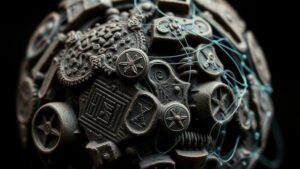Using AI to Automate Research in Large Historical Artifact Databases
Using AI to Automate Research in Large Historical Artifact Databases
The integration of artificial intelligence (AI) into historical research has the potential to revolutionize the way scholars and institutions analyze large databases of artifacts. With over 1.8 billion cultural objects worldwide, the challenge of efficiently managing and interpreting historical data has become increasingly relevant. This article explores how AI can be employed to automate research in large historical artifact databases, enhancing scholarly research and improving accessibility to information.
The Need for Automation in Historical Research
Historical research often involves the analysis of extensive datasets, which can encompass various forms of artifacts including documents, photographs, and physical objects. Traditional methods of research frequently rely on human input to catalog, analyze, and interpret these artifacts. This manual process is not only time-consuming but also prone to human error. According to a study published in the journal Digital Scholarship in the Humanities, researchers spend approximately 60% of their time on data collection and organization instead of analysis (Pritchard, 2021).
Challenges in Managing Historical Data
Several key challenges impede the efficient management of historical artifact databases:
- Data Volume: Large databases can contain millions of entries, making it difficult for researchers to locate specific artifacts or patterns.
- Data Quality: Inconsistencies in how data is recorded can lead to inaccuracies and complicate research efforts.
- Resource Limitations: Many institutions lack the funding and manpower to interrogate large datasets thoroughly.
Applications of AI in Historical Artifact Research
AI technologies, such as machine learning (ML) and natural language processing (NLP), can greatly alleviate these challenges. By automating data analysis, AI enables researchers to focus on interpretation rather than data entry. The following applications illustrate how AI is currently being implemented in the field:
Automated Cataloging and Classification
AI algorithms can automate the cataloging of artifacts by analyzing images and textual descriptions. For example, the Smithsonian Institution utilizes computer vision algorithms to classify and tag images of historical artifacts, drastically reducing the time required for data entry and classification. This not only improves efficiency but also enhances the searchability of the collections.
Data Analysis and Pattern Recognition
Machine learning models can identify patterns and correlations in historical data that may not be immediately evident to human researchers. A notable example is the Europeana Collections. This digital platform employs AI to analyze usage data, which helps historians recognize trends and user interests in different artifacts. By processing vast amounts of data, ML can highlight valuable insights that support historical interpretations.
NLP for Textual Analysis
Natural language processing allows researchers to sift through historical documents and texts, extracting relevant information swiftly. The Digital Public Library of America has utilized NLP to analyze large volumes of public domain texts, making it easier to index and search through historical documents. This approach significantly reduces the time required for traditional textual analysis.
Case Studies and Current Useations
Several institutions have already started leveraging AI technologies to enhance their research capabilities. Below are notable case studies:
- The British Museum: The museum has implemented AI-driven tools to improve artifact recognition and to enhance the visitor experience through personalized recommendations.
- The Getty Research Institute: AI has been utilized for digitizing and cataloging art collections, enabling researchers to access and analyze artifacts more efficiently.
- The Rijksmuseum: Leveraging AI, the Rijksmuseum has created a virtual assistant to help researchers and visitors navigate its vast digital collections effectively.
Potential Concerns and Ethical Considerations
While the automation of historical research through AI presents numerous benefits, it also raises potential concerns:
- Data Privacy: Ensuring that personal and sensitive data is handled responsibly and ethically is paramount.
- Bias in Algorithms: AI systems can inherit biases from the data they are trained on, which can lead to flawed interpretations. Continuous monitoring and refinement of algorithms are essential.
Conclusion and Future Directions
The integration of AI into the research of large historical artifact databases represents a significant advancement in the field of historical scholarship. By automating tedious processes, AI allows researchers to focus on analysis and interpretation, facilitating new discoveries in history. As technologies continue to evolve, it will be crucial to address ethical considerations and ensure the responsible use of AI in this context.
Moving forward, institutions should invest in advanced AI techniques and foster collaborations with tech developers to harness full potential of AI in historical research. By doing so, we can ensure that the rich tapestry of history is more accessible than ever before, benefiting scholars, artists, and the general public.
References
- Pritchard, R. (2021). Challenge of Digital Scholarship. Digital Scholarship in the Humanities, 36(1), 120-134.
- Smithsonian Institution. (n.d.). Artificial Intelligence and Collections.
- Europeana Collections. (n.d.). AI and Big Data: The Future of Cultural Heritage.
- Digital Public Library of America. (n.d.). Text Mining the DPLA.
- British Museum. (n.d.). AI Technology in Museums.
- Getty Research Institute. (n.d.). Digital Catalog Program.
- Rijksmuseum. (n.d.). Museum Assistant AI Useation.


